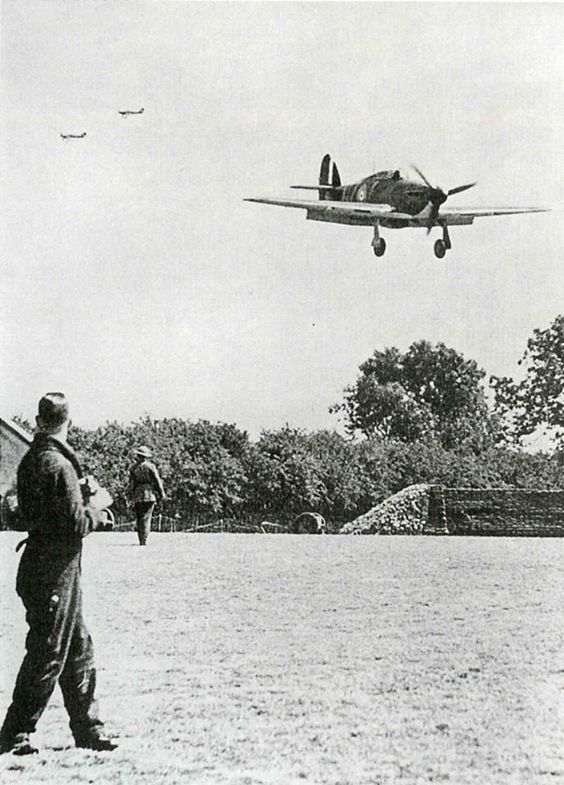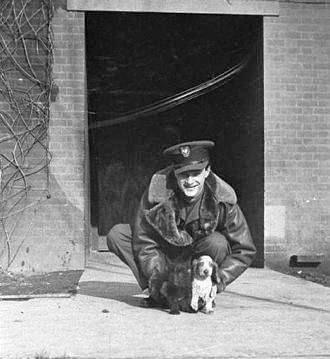Friday 2 August 1940
 |
| Using a bomb trolley to load up a Handley Page Hampden, 2 August 1940. |
Both sides lose planes for a variety of causes. Several Luftwaffe bombers fail to return for unknown reasons. The RAF losses, on the other hand, are a sign of a strained air force. For instance, a Spitfire of RAF No. 504 Squadron flips over on take-off at Hornchurch, a Blenheim bomber of RAF No. 219 Squadron overshoots the runway at Leeming airfield, and a Spitfire crashes on take-off whilst on night patrol at Rochford Airfield, killing pilot Squadron leader Cecil Sawyer of No. 65 Squadron. Pilots are tired, training hours have been cut, there are insufficient lighting and support for night operations, and sorties must be conducted despite extreme conditions that would never be tolerated in peacetime.
The official tally from some sources is four lost RAF planes with two pilots lost, and about a dozen Luftwaffe planes lost with 19 pilots missing or dead. However, aircraft losses during the Battle of Britain are an extremely sensitive topic, and also can be imprecise for very innocent reasons. For instance: do you count losses during the RAF bomber raids on the Continent, "accidental" losses, planes which land but are greatly damaged? If so, the figures shift appreciably.
A group of Heinkel He 111s attack shipping off Yarmouth, but are shooed away by Spitfires of RAF No. 19 Squadron based at Duxford.
A formation of Heinkel He 115 seaplanes later attacks the freighter Highlander off Stonehaven. The planes make strafing runs when their bombs miss, and one of them accidentally hits the ship in an unintended Kamikaze-style incident, spinning onto its poop deck after striking a lifeboat davit. The Highlander is only lightly damaged and returns to port with a largely intact He 115 on its deck. The formation also loses another plane to anti-aircraft fire from escort sloop HMS Weston. It is unknown what happened to the crews.
At night, the Luftwaffe continues its pattern of sending an assortment of solo raiders. The raids focus on the west coast of England and Wales and the midlands. There is minelaying in the usual spots such as the Thames Estuary, Aberdeen and elsewhere along the northeast coast, and East Anglia.
While planes do not attack London, some do come into the central area there (known as the London Artillery Zone) apparently for reconnaissance purposes. Swansea gets hits, causing five casualties. The Bristol Aeroplane Company at Filton, a favorite Luftwaffe target, is bombed.
There are some isolated German successes. The Luftwaffe sinks Royal Navy anti-submarine trawler HMS Cape Finisterre traveling in a convoy off Harwich. One crewman perishes.
The Luftwaffe badly damages 8006 British freighter City of Brisbane in the Thames Estuary. Run aground to keep it from sinking, the freighter blazes for days. There are 8 deaths.
RAF Bomber Command attacks the Channel Ports with Blenheim bombers, losing several planes. Victory claims are filed by pilots from 4,/JG54, 7,/JG54 and I,/JG2. Bomber Command also launches daylight raids on airfields and oil installations across northwest Europe.
RAF No. 303 (Polish "Kosciuszko") Squadron forms at Northolt from personnel of No. 111 and 112 Squadrons of the Pursuit Brigade. It is the second "Polish" Squadron (that is an informal, not RAF, designation). These "foreign" squadrons are not popular with the top RAF brass due to the unknown quality of their pilots, but they perform quite well. In fact, some consider the Polish Squadrons to be the most effective in the entire RAF. One of 303 Squadron's pilots, Sgt. Josef Frantisek officially joins the RAF and becomes a top ace.
Luftwaffe planes continue dropping copies of Adolf Hitler's 19 July 1940 "Last Appeal to Reason" speech. These at the time are becoming souvenirs and conversation pieces, and over time have become collector's items.
 |
| Sgt Eugeniusz Szaposznikow (far right) and others of No 303 (Polish) Squadron RAF at RAF Northolt at its formation on 2 August 1940. |
The large flotilla of ships in Force H (including battlecruiser HMS Hood, battleships HMS Valiant and Resolution, two cruisers and many destroyers) is at a vulnerable point south of Sardinia. At 02:30, the Argus launches the Hurricanes. As part of the diversionary strategy that includes Operation Spark off Minorca, the Ark Royal attempts to send nine torpedo bombers to attack shipping and airfields around Cagliari at the same time. However, the weather closes in and one plane is lost with its crew, scrubbing the mission until daylight. Several hours later, the attack proceeds, scoring hits on airfields and laying mines despite the intense anti-aircraft fire. They lose one more Swordfish.
The Hurricanes fly off and reach Hal Far airfield Malta around 08:30, greatly strengthening the island's defenses. One Hurricane crashes near the field with engine failure, and the airfield's commander personally drives at madcap speed to the scene and rescues the pilot, Pilot/Sergeant F N Robertson of 66 Squadron. An escorting Skua also crashes on landing but later returns to operation.
The Hurricanes from RAF No. 261 Squadron. Separately, the British submarines HMS Proteus and Pandora arrive in Malta with crews for anti-aircraft guns. There are no air raids during the day, the Regia Aeronautica perhaps distracted by the diversionary operations conducted by the Royal Navy throughout the Mediterranean.
Force H, its mission complete, scrambles back to Gibraltar, pursued fruitlessly by 8 Italian submarines. Some of its ships, including the battleships and HMS Hood, split off for further operations.
Royal Navy submarine HMS Thames is sunk around this date by a mine (exact dates for these types of incidents are uncertain).
A Lockheed Hudson from RAF No. 220 Squadron spots U-37 and U-38 together on the surface in the North Sea at 15:08. It attacks without results. In addition, about an hour later after the U-boats split up, Royal Navy submarine O-21 spots one of them and fires two torpedoes at them from extremely long-range, missing.
Kapitänleutnant Otto Kretschmer in U-99 stalks Convoy OB 191 in the Atlantic about 340 miles west of Ireland throughout the day. He has success, but heroic efforts by his victims' crews prevent him from gaining victories.
U-99 torpedoes Norwegian tanker Strinda amidships at 02:51. The crew abandons ship in the dark but reboards it four hours later after the morning light shows it still afloat. They manage to re-start the engines and bring the tanker to port. Tankers are difficult to sink due to their inherent design.
U-99 then torpedoes at 03:43 the tanker Lucerna. Kretschmer surfaces and shells the ship with gunfire when it doesn't sink quickly. However, the tanker manages to elude the U-boat and later makes port.
U-99 then tries again and torpedoes tanker Alexia. The same pattern asserts itself, with the tanker badly damaged but remaining afloat. Once again, Kretschmer surfaces to shell the ship, but it also remains afloat and proceeds on its way.
Convoy FN 240 departs from Southend, Convoy MT 128 departs from Methil, Convoy FS 239 departs from the Tyne, Convoy OG 40 departs from Liverpool, Convoys SL 42 and SLF 42 depart from Freetown.
The Royal Navy reorganizes its Home Fleet destroyers into four flotillas (Destroyer Flotillas 3, 4, 6 and 12) of about 7-8 destroyers each.
British corvette HMS Peony (K 40, Lt. Commander Martyn B. Sherwood) is commissioned.
 |
| Hurricanes of RAF No 32 Squadron fly into Biggin Hill, August 1940. |
The RAF bombs Italian positions at Zula, Eritrea and other locales in the vicinity.
US Government: President Roosevelt and his cabinet bruit about ways to transfer 50 or 60 destroyers to the British, which all agree is necessary and proper. It is all about finding some legal way to do it.
President Roosevelt says that the draft is necessary because there is a "real possibility the US will soon have to fight alone."
General Spaatz meets with "Wild Bill" Donovan in London about the status of the Battle of Britain.
Soviet/German Relations: Soviet Foreign Minister Molotov confirms the alliance with Germany despite strains in the relationship over Soviet territory grabs in Romania and various issues over trade.
German Foreign Minister Ribbentrop asks the German Ambassador to Moscow, Count von Schulenburg, to ask Molotov what it would be willing to give up in exchange for its desire (expressed on 13 July to the ambassador) to retain the strip of Lithuanian territory allocated to Germany under the secret protocols of the Ribbentrop/Molotov Pact of 23 August 1939.
German Government: Abwehr chief Admiral Canaris, back from his visit to Spain, discusses the prospects for invading Gibraltar with General Keitel (Operation Felix).
British Government: Canadian businessman William Maxwell "Max" Aitken, 1st Baron Beaverbrook ("Lord Beaverbrook"), Minister of Supply for Aircraft Production, joins Prime Minister Winston Churchill's inner "War Cabinet."
"Photoflash" reconnaissance shows that RAF bombing accuracy is extremely poor. This is a subject that will occupy a lot of staff work and study during the war. The Luftwaffe's accuracy also is poor when the target is isolated factories and other industrial targets rather than large cities.
Vichy France: The trial against Free French General Charles de Gaulle concludes with a death sentence. They also seize his property.
Strict rationing imposed due to the British blockade.
Luxembourg: Germany appoints a civilian administrator over Luxembourg to replace the military governor.
USSR: The Moldavian SSR is formed from former Romanian territory in Bessarabia and Northern Bukovina.
Holocaust: The restrictions on German Jews continue growing. Jewish Germans are now banned from owning telephones and may shop during certain hours in the afternoon. Jewish hospitals are not allowed to paint a red cross on the roof to deter bombing. The ironic thing from the German point of view is that many non-Jewish German citizens suffer due to such petty and ridiculous laws.
 |
| French soldiers pose for a tourist snapshot in front of the Arc de Triomphe some time during August 1940. |
August 1, 1940: Two RN Subs Lost
August 2, 1940: Operation Hurry
August 3, 1940: Italians Attack British Somaliland
August 4, 1940: Dueling Legends in the US
August 5, 1940: First Plan for Barbarossa
August 6, 1940: Wipe Out The RAF
August 7, 1940: Burning Oil Plants
August 8, 1940: True Start of Battle of Britain
August 9, 1940: Aufbau Ost
August 10, 1940: Romania Clamps Down On Jews
August 11, 1940: Huge Aerial Losses
August 12, 1940: Attacks on Radar
August 13, 1940: Adler Tag
August 14, 1940: Sir Henry's Mission
August 15, 1940: Luftwaffe's Black Thursday
August 16, 1940: Wolfpack Time
August 17, 1940: Blockade of Britain
August 18, 1940: The Hardest Day
August 19, 1940: Enter The Zero
August 20, 1940: So Much Owed By So Many
August 21, 1940: Anglo Saxon Incident
August 22, 1940: Hellfire Corner
August 23, 1940: Seaplanes Attack
August 24, 1940: Slippery Slope
August 25, 1940: RAF Bombs Berlin
August 26, 1940: Troops Moved for Barbarossa
August 27, 1940: Air Base in Iceland
August 28, 1940: Call Me Meyer
August 29, 1940: Schepke's Big Day
August 30, 1940: RAF's Bad Day
August 31, 1940: Texel Disaster
2020

No comments:
Post a Comment